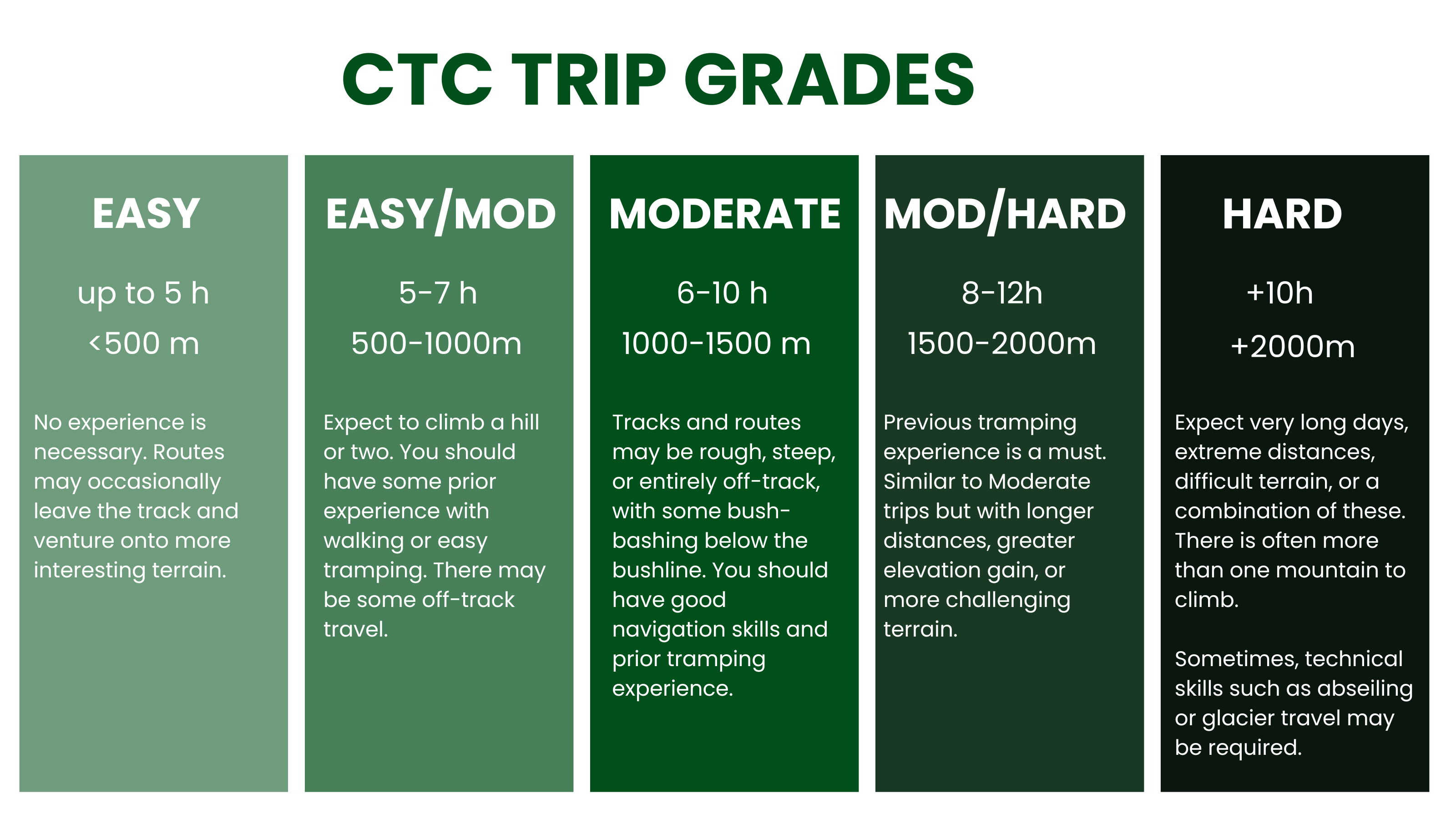CTC trips range from Easy (requiring minimal experience) to Hard (demanding extensive experience). Newcomers are encouraged to start with Easy or Easy/Moderate day trips and gradually progress one grade at a time. If you're unsure whether a trip is suitable for you, consult your trip leader, Club Captain, or Trip Organiser.
Once you're confident at a particular grade, you can challenge yourself by moving up to the next level, starting with trips at the easier end of that grade.
Trip grades are based on factors such as total height gain, distance, walking hours per day, terrain difficulty, pace and seasonal conditions. The poster below provides a simplified overview of our grading system, with further examples and explanations below.

More about trip grades
Some trip leaders use a “+” when grading their trips (e.g., “Moderate+”) to indicate that the trip is at the higher end of the assigned grade.
When a trip's difficulty is uncertain, our leaders are encouraged to grade it conservatively by selecting a harder grade. The reasoning behind this practice includes:
- A trip is rarely easier than expected but is often harder.
- Experienced members are expected to assess the grade and determine their suitability for the trip.
The grade should take all factors into account, including the time of year, terrain, and trip length.
- For example, a two-day West Coast trip with 8-hour days should be graded at least Moderate/Hard due to the challenging terrain and the added difficulty of carrying an overnight pack.
- Similarly, a winter trip may be significantly more demanding than the same route in summer, and this should be reflected in the grading. Backpacks are heavier, daylight hours are scarce, and snow makes walking more challenging.
- In the same manner, if a trip leader intends to maintain a pace that would be considered fast for the average tramper, the trip leader is encouraged to grade their trips harder or at least specify the pace.
Examples of trips in particular grades
Easy
- Purau from Diamond Harbour
- Quail Island
- Bridle Path from Gondola to Lyttelton
- Mt Vulcan
- Anti Crow Hut return trip
Easy/Mod
- Mt Thomas
- Mt Richardson
- Peak Hill
- Mt Grey
- My Lyndon
- Helicopter Hill
- Bealey Spur Hut
- Leith Hill
Moderate
- Mt Oxford (somewhat controversial to grade as moderate due to its 1000 m ascent on a marked route, but since we should err on the side of harder grading if unsure, it is considered moderate)
- Avalanche Peak (marked track, well-trodden, about 1000 m ascent)
- Mt Bealey
- Castle Hill Peak
- Mt Somers Loop
- Mt Norma return
Mod/Hard
- The Gap (challenging terrain, long day, off-track travel, potential exposure)
- Mt Aicken (difficult terrain, exposure)
- Winter trips in the Craigieburns or Arthur’s Pass, where heavy snow can be expected
- Mons Sex Millia from Boyle Village via Pk 1471 (9-hour trip with total height gain of 1520 m)
- Mt Somers Loop in a day (long day with significant height gain)
- Travers- to Trovatore Loop
- The Pyramid via Sudden Valley (challenging terrain, exposure)
- Mt Foweraker
- Rome Ridge
- Avalanche - Bealey traverse.
Hard
- Winter day trips like Mt Enys or Moorhouse Peak (close to or over 2000 m height gain)
- Craigieburn Range Traverse
- Torlesse Range Traverse
- Day trips with extreme distances, e.g., Hump Ridge Track (60 km), Paparoa Track (50 km), St James Walkway (66 km), and similar
- Any trips involving rope skills
- Overnight trips with more than one day of Mod/Hard days
